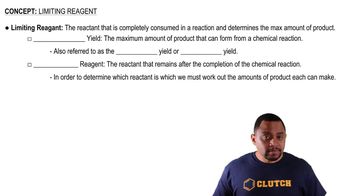For the reaction shown, calculate the theoretical yield of product (in grams) for each initial amount of reactants. 2 Al(s) + 3 Cl2(g) → 2 AlCl3(s) c. 0.235 g Al, 1.15 g Cl2

For the reaction shown, calculate the theoretical yield of the product (in grams) for each initial amount of reactants. Ti(s) + 2 F2( g) → TiF4(s) c. 0.233 g Ti, 0.288 g F2
 Verified step by step guidance
Verified step by step guidance
Verified video answer for a similar problem:
Key Concepts
Stoichiometry

Molar Mass

Limiting Reactant

Iron(III) oxide reacts with carbon monoxide according to the equation: Fe2O3(s) + 3 CO(g) → 2 Fe(s) + 3 CO2(g) A reaction mixture initially contains 22.55 g Fe2O3 and 14.78 g CO. Once the reaction has occurred as completely as possible, what mass (in g) of the excess reactant remains?
Elemental phosphorus reacts with chlorine gas according to the equation: P4(s) + 6 Cl2( g) → 4 PCl3(l) A reaction mixture initially contains 45.69 g P4 and 131.3 g Cl2. Once the reaction has occurred as completely as possible, what mass (in g) of the excess reactant remains?
Magnesium oxide can be made by heating magnesium metal in the presence of oxygen. The balanced equation for the reaction is: 2 Mg(s) + O2(g) → 2 MgO(s) When 10.1 g of Mg reacts with 10.5 g O2, 11.9 g MgO is collected. Determine the limiting reactant, theoretical yield, and percent yield for the reaction.
